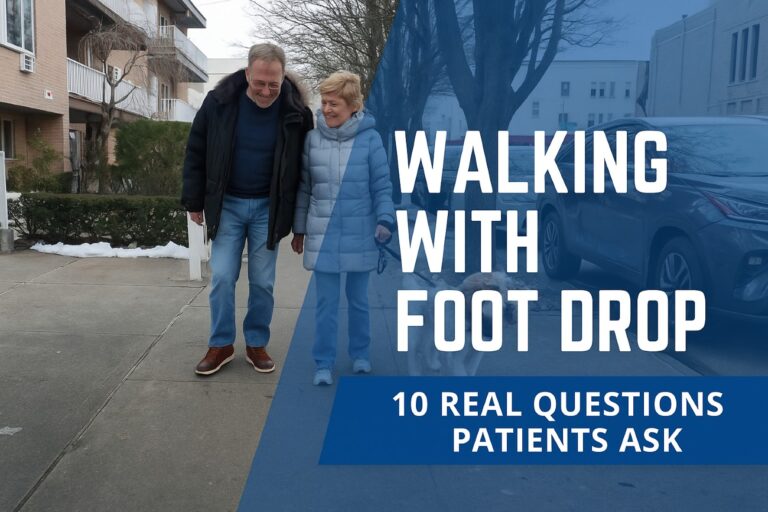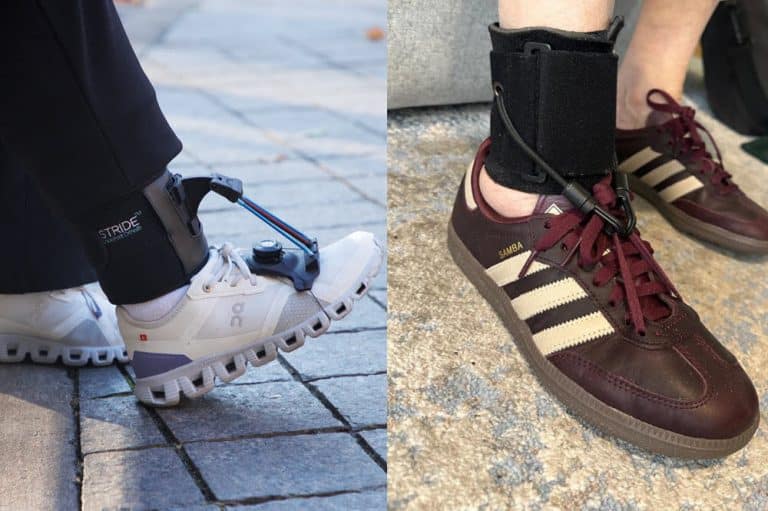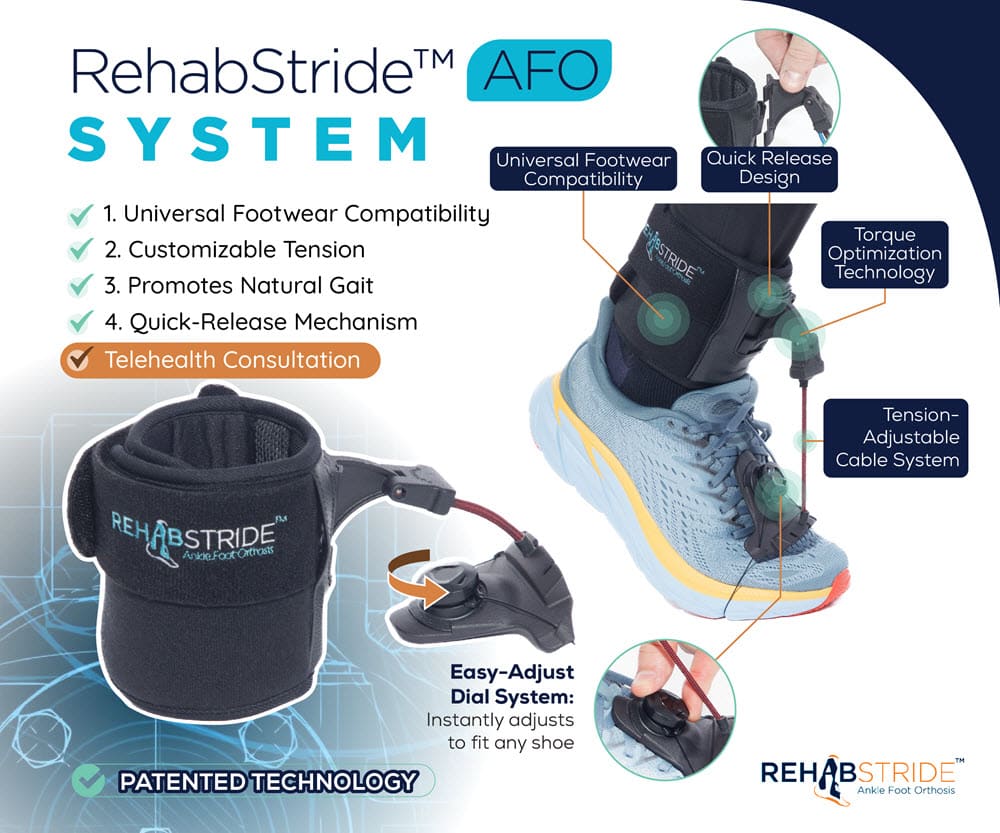
By Gene Shenker, DPT, Founder & CEO, RehabStride™ AFO
Foot drop, sometimes referred to as drop foot, is a mobility challenge that makes it difficult to lift the front part of the foot while walking. This condition is typically caused by neurological or muscular impairments, including stroke, multiple sclerosis (MS), peripheral nerve injury, or spinal cord trauma.¹ It can lead to tripping, instability, and reduced independence if not managed properly.
Thankfully, modern solutions like the RehabStride™ AFO brace are helping individuals overcome the limitations of foot drop and restore natural, confident walking.
Let’s explore the top 10 questions real patients ask about walking with foot drop—and how the RehabStride™ AFO offers game-changing support.
1. Is it possible to walk again with foot drop?
Yes, absolutely. With proper management, including an AFO (ankle-foot orthosis) or dynamic foot drop brace, walking is not only possible but often much safer. The RehabStride™ AFO supports the foot during swing phase by lifting the toes, improving balance and reducing fall risk.
2. What’s the difference between RehabStride™ and a traditional AFO?
Conventional AFOs are usually rigid plastic devices worn inside the shoe. While they prevent toe drag, they also restrict ankle motion and often require special footwear. In contrast, RehabStride™ offers active dorsiflexion assist, powered by a tension-adjustable cable system. Its lightweight design supports more natural movement while fitting into most regular shoes—no bulky orthopedic shoes needed.
| Feature | Traditional AFO | RehabStride™ AFO |
|---|---|---|
| Shoe Compatibility | Often requires special shoes | Fits most sneakers and casual shoes |
| Ankle Movement | Restricted | Allows natural motion |
| Dorsiflexion Support | Fixed or rigid | Adjustable tension system |
| Comfort | Bulky & hard | Lightweight & ergonomic |
| Push-Off Assistance | None | Torque-optimized lift-off |
| Onboarding Support | None | Includes virtual setup with licensed therapist |

3. Do I need to use a foot brace all day?
Most patients with moderate to severe foot drop benefit from daily brace use, especially when walking outside or on uneven surfaces. RehabStride™ is designed for long-term wear, offering comfort, breathability, and an ergonomic fit. You can also adjust the tension throughout the day, depending on your activity level or fatigue.
4. Can I run or hike again with foot drop?
For some individuals, yes. While not every case allows for high-impact activity, many people can build up to jogging, hiking, or active walking with the right combination of bracing and physical therapy.² RehabStride™ AFO’s lightweight frame and dynamic support make it ideal for those pursuing active recovery goals. However, any high-impact activities should be approved by your healthcare provider.
5. Will I need to wear specific shoes with this brace?
Not with RehabStride™. Unlike many traditional AFOs, which require extra-wide or customized footwear, the RehabStride™ AFO is engineered to work with most athletic or casual shoes. This is a major advantage for patients who want to maintain their lifestyle without making drastic wardrobe changes.
6. How does the adjustable tension system help?
The RehabStride™ tension dial lets you fine-tune the amount of lift you need. This personalization helps accommodate changes throughout the day or activity type, and also supports muscle reactivation by engaging dorsiflexors more naturally than fixed-position braces.
7. Can I wear the brace on both feet?
Yes. If you have bilateral foot drop (affecting both feet), you can wear a RehabStride™ brace on each side. The design is symmetrical and optimized for use with either the left or right foot. Be sure to order the correct size for each side and consult your provider for guidance.
8. Does this brace help with neurological recovery?
While no device can guarantee full recovery, RehabStride™ supports functional improvement by allowing users to walk with better mechanics. This enhances proprioception (awareness of foot position) and may stimulate neural pathways involved in gait, especially when combined with physical therapy and exercise.³
9. How long will I need to wear the brace?
There’s no universal timeline—it depends on your underlying condition, therapy progress, and personal goals. Some people use the RehabStride™ AFO as a long-term solution, while others may eventually transition away from bracing if their condition improves.
10. How do I know RehabStride™ is right for me?
If you’re struggling with foot drop and want a brace that’s lightweight, customizable, and compatible with daily life, RehabStride™ is an excellent option. It includes a free virtual onboarding session with a licensed therapist to ensure a proper fit and personalized tension setup.
🦶 Final Thoughts: Take Your First Step with Confidence
If you’re struggling with foot drop and want a brace that’s lightweight, customizable, and compatible with daily life, RehabStride™ is an excellent option. It includes a free virtual onboarding session with a licensed therapist to ensure a proper fit and personalized tension setup.
Managing foot drop can feel overwhelming—but with the right tools and mindset, walking doesn’t have to be a struggle. The RehabStride™ AFO brace provides more than just lift—it delivers independence, safety, and comfort.
Whether you’re recovering from a neurological condition, dealing with chronic nerve damage, or simply trying to stay active, RehabStride™ helps you move forward, one step at a time.
🔗 Learn More:
Visit the RehabStride™ Product Page
📞 Free U.S. & Canada shipping | 🎯 FSA/HSA eligible | 💬 1-on-1 virtual setup included
📚 References:
Mayo Clinic. Foot Drop – Symptoms and Causes. Retrieved from: https://www.mayoclinic.org/diseases-conditions/foot-drop/diagnosis-treatment/drc-20372633
National MS Society. Foot Drop and MS: A Guide to Support and Exercise. Retrieved from: https://www.nationalmssociety.org
Yamamoto S, et al. Clinical evaluations of dorsiflexion assist controlled by spring ankle-foot orthosis for hemiplegic patients. PubMed. PMID: 9551524

Related posts:
- Breaking Myths About AFO Braces: What You Need to Know
- The Role of Dorsi Flexion in Safe and Stable Walking: What You Need to Know
- Ankle Foot Orthosis Demystified: Choosing the Right Brace for You
- Step Into the Future: Discover the Power of RehabStride AFO Brace for Foot Drop Recovery
- Top 7 Ways RehabStride™ AFO Brace Enhances Your Daily Activities and Independence
